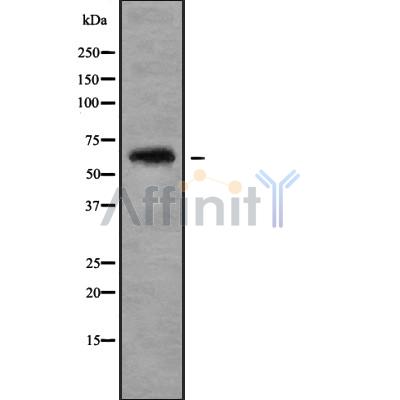AOAH Antibody - #DF9158
| Product: | AOAH Antibody |
| Catalog: | DF9158 |
| Description: | Rabbit polyclonal antibody to AOAH |
| Application: | WB IHC |
| Reactivity: | Human, Mouse, Rat |
| Prediction: | Pig, Bovine, Horse, Sheep, Rabbit, Dog |
| Mol.Wt.: | 65 kDa; 65kD(Calculated). |
| Uniprot: | P28039 |
| RRID: | AB_2842354 |
Related Downloads
Protocols
Product Info
*The optimal dilutions should be determined by the end user.
*Tips:
WB: For western blot detection of denatured protein samples. IHC: For immunohistochemical detection of paraffin sections (IHC-p) or frozen sections (IHC-f) of tissue samples. IF/ICC: For immunofluorescence detection of cell samples. ELISA(peptide): For ELISA detection of antigenic peptide.
Cite Format: Affinity Biosciences Cat# DF9158, RRID:AB_2842354.
Fold/Unfold
Acyloxyacyl hydrolase (neutrophil); Acyloxyacyl hydrolase large subunit; AOAH; AOAH_HUMAN;
Immunogens
- P28039 AOAH_HUMAN:
- Protein BLAST With
- NCBI/
- ExPASy/
- Uniprot
MQSPWKILTVAPLFLLLSLQSSASPANDDQSRPSLSNGHTCVGCVLVVSVIEQLAQVHNSTVQASMERLCSYLPEKLFLKTTCYLVIDKFGSDIIKLLSADMNADVVCHTLEFCKQNTGQPLCHLYPLPKETWKFTLQKARQIVKKSPILKYSRSGSDICSLPVLAKICQKIKLAMEQSVPFKDVDSDKYSVFPTLRGYHWRGRDCNDSDESVYPGRRPNNWDVHQDSNCNGIWGVDPKDGVPYEKKFCEGSQPRGIILLGDSAGAHFHISPEWITASQMSLNSFINLPTALTNELDWPQLSGATGFLDSTVGIKEKSIYLRLWKRNHCNHRDYQNISRNGASSRNLKKFIESLSRNKVLDYPAIVIYAMIGNDVCSGKSDPVPAMTTPEKLYSNVMQTLKHLNSHLPNGSHVILYGLPDGTFLWDNLHNRYHPLGQLNKDMTYAQLYSFLNCLQVSPCHGWMSSNKTLRTLTSERAEQLSNTLKKIAASEKFTNFNLFYMDFAFHEIIQEWQKRGGQPWQLIEPVDGFHPNEVALLLLADHFWKKVQLQWPQILGKENPFNPQIKQVFGDQGGH
Predictions
Score>80(red) has high confidence and is suggested to be used for WB detection. *The prediction model is mainly based on the alignment of immunogen sequences, the results are for reference only, not as the basis of quality assurance.
High(score>80) Medium(80>score>50) Low(score<50) No confidence
PTMs - P28039 As Substrate
| Site | PTM Type | Enzyme | Source |
|---|---|---|---|
| N59 | N-Glycosylation | Uniprot | |
| T132 | Phosphorylation | Uniprot | |
| S157 | Phosphorylation | Uniprot | |
| N207 | N-Glycosylation | Uniprot | |
| Y334 | Phosphorylation | Uniprot | |
| S377 | Phosphorylation | Uniprot | |
| T387 | Phosphorylation | Uniprot | |
| N409 | N-Glycosylation | Uniprot | |
| Y432 | Phosphorylation | Uniprot | |
| N466 | N-Glycosylation | Uniprot |
Research Backgrounds
Removes the secondary (acyloxyacyl-linked) fatty acyl chains from the lipid A region of bacterial lipopolysaccharides. By breaking down LPS, terminates the host response to bacterial infection and prevents prolonged and damaging inflammatory responses (By similarity). In peritoneal macrophages, seems to be important for recovery from a state of immune tolerance following infection by Gram-negative bacteria (By similarity).
Cleaved into a large and a small subunit.
The small subunit is N-glycosylated.
Secreted. Cytoplasmic vesicle.
Note: Detected in urine.
Heterodimer of the large and small subunits; disulfide-linked.
Restrictive clause
Affinity Biosciences tests all products strictly. Citations are provided as a resource for additional applications that have not been validated by Affinity Biosciences. Please choose the appropriate format for each application and consult Materials and Methods sections for additional details about the use of any product in these publications.
For Research Use Only.
Not for use in diagnostic or therapeutic procedures. Not for resale. Not for distribution without written consent. Affinity Biosciences will not be held responsible for patent infringement or other violations that may occur with the use of our products. Affinity Biosciences, Affinity Biosciences Logo and all other trademarks are the property of Affinity Biosciences LTD.




